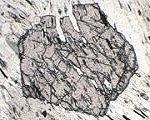Practical Aspects of Mineral Thermobarometry
Data File Construction: activity coding
Annotated code examples
- Garnet
- Biotite
- Chlorite
- Cordierite (coming soon)
- Muscovite (coming soon)
- Orthopyroxene (coming soon)
- Omphacite and other sodic pyroxenes
- Sodic amphibole: glaucophane/crossite
Notes on coding for mineral solid solutions
The new pattern for coding activity-composition relations in THERMOCALC 3 has some advantages in logic and clarity over the earlier system. Here's an example for Fe-Mg-Ca garnet, from which one can see how a data file is constructed:
%___________________________________________ g 3 x(g) 0.95 % Fe/(Fe+Mg) z(g) 0.03 % Ca/(Fe+Mg+Ca) p(gr) 1 1 0 1 1 z p(alm) 1 2 1 1 -1 z 0 1 1 x p(py) 1 2 1 1 -1 z 1 1 -1 x sf W(gr,alm) 0 0 0 W(gr,py) 33 0 0 W(alm,py) 2.5 0 0 3 xFeM1 1 2 1 1 -1 z 0 1 1 x xMgM1 1 2 1 1 -1 z 1 1 -1 x xCaM1 1 1 0 1 1 z gr 1 1 xCaM1 3 alm 1 1 xFeM1 3 py 1 1 xMgM1 3 % ___________________________________________
So, the generalised structure is as follows:
- The first line consists of the phase name and the number of end members it is made up of.
- Next the composition variable names are defined (x and z in this case) and initial values given. It's usually wise to choose values similar to those expected in the calculated result.
- Then the end member names are listed, along with the formulae for calculating proportions of them in terms of the composition variables. The sequence you give them in controls the sequence in which the ideal activity expressions and the interactions parameters must be supplied. Some thought has to be given to these, as they are used both to calculate activity coefficients and to reconstruct the bulk composition of the phase from the composition variables.
- Then you indicate what solution model to use (sf = symmetric formalism, ideal = ideal mixing on sites)
- If symmetric formalism is chosen, you then list the W's. If the end members are 1, 2, 3, these are given in the order W12, W13, W23.
- Next, you tell the program how many site fractions are needed to work out the activities, and define the names of these site fractions along with instructions on how to calculate them from the composition variables.
- Finally you tell the program how to calculate the (ideal) mixing-on-sites activities of each end member, in terms of the site fractions. They must be listed in the same sequence as in section 3 above.
This page last modified 12 October 2004
